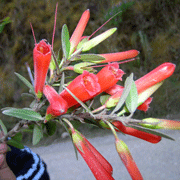James L. Luteyn and Paola Pedraza-Peñalosa
The New York Botanical Garden
|
|
Demosthenesia is a neotropical genus, consists of about 11 species, ranging from Peru to N Bolivia. It is probably related to Thibaudia, but is distinguished by its continuous calyx with elongate lobes, often large corollas, usually slightly dimorphic stamens, elongate tubules, and "pseudo-stipules" (Smith, 1936; Luteyn, 1978). |
Terrestrial or usually epiphytic shrubs, sometimes lianoid, often with lignotubers, pubescence often glandular, stems often with swollen nodes; bud scales often subulate. Leaves alternate or rarely opposite, evergreen, coriaceous, pinnately or plinerved, margin entire or remotely crenate, short-petiolate. Infloresence axillary, solitary to fasciculate or racemose, with 1-4 (-20) pedicellate flowers; floral bract inconspicuous; bracteoles 2. Flowers 5-merous, without odor; aestivation valvate; calyx continuous with pedicel; hypanthium obconic and terete to angled or slightly winged; limb suberect and longer than the hypanthium; lobes 5, often elongate; corolla cylindric or rarely urceolate, carnose, sometimes large (to 5 cm long), the lobes 5; stamen 10, about equalling the corolla, often slightly alternately unequal; filaments distinct, equal or alternately unequal, pilose, lacking spurs, shorter than anthers; anthers submembranous, lacking disintegration tissue; thecae slightly granular; tubules broad, flexible, 2-6 times longer than the thecae, dehiscing by elongate clefts or oblique flaring pores; pollen without viscin threads; ovary inferior; style filiform; nectariferous disc annular. Fruit a spherical, blue-black berry.
Key to Neotropical Species Back to Top
1. Corolla 6-8 mm long ..................................................... (2)
1. Corolla 17-50 mm long.................................................. (3)
2. Pedicels 6-12 mm long; leaves 15-22 mm long .............Demosthenesia pearcei
2. Pedicels 3-6 mm long; leaves 8-12 mm long ................ Demosthenesia weberbauerii
2. Pedicels 10-20 mm long; leaves 8-15 mm long ............ Demosthenesia buxifolia
3. Leaves alternate........................................................... (4)
3. Leaves opposite........................................................... (6)
4. Corolla 20-30 mm long and 3-8 mm diam., (slightly)
zygomorphic ............................................................... Demosthenesia mandoni
4. Corolla 35-60 mm long and 7-15 mm diam.,
actinomorphic............................................................. (5)
5. Corolla 35-50 mm long and 7-10 mm diam.; leaf nodes
swollen and raised; leaves 2-3 cm long, pinnately
nerved; pedicel 6-10 mm long; calyx ca. 11 mm long.... Demosthenesia spectabilis
5. Corolla 50-60 mm long and 10-15 mm diam.; leaf nodes
flush with stem; leaves 7-12 cm long, plinerved;
pedicel 40-50 mm long; calyx 36-46 mm long ............. Demosthenesia vilcabambensis
6. Plants glabrous (except staminal filaments); leaf
margin remotely glandular crenate; inflorescences
fasciculate, the rachis none; pedicels 30-40 mm long;
calyx 15-16 mm long, the lobes 10-12 mm long; corolla
42-50 mm long ........................................................ Demosthenesia cordifolia
6. Plants short-white-pilose; leaf margin entire;
inflorescences racemose, the rachis 2-5 cm long;
pedicels 10-18 mm long; calyx 5-10 mm long, the lobes
3.5-8 mm long; corolla 17-22 mm long ..................... (7)
7. Leaf nodes flush with stem; petiole 2.5-5 mm long;
rachis glandular- fimbriate; pedicels 10 mm long;
calyx 5-6 mm long, the lobes ovate, 3.5 mm long;
corolla gradually spreading towards apex, without
glandular fimbriae; staminal filaments alternately
unequal, without glandular fimbriae dorsally ........Demosthenesia oppositifolia
7. Leaf nodes swollen and raised; petiole <2 mm long;
rachis eglandular; pedicels 18 mm long; calyx 10 mm
long, the lobes oblanceolate, 6-8 mm long; corolla
widest at base, with glandular fimbriae ...............Demosthenesia dudleyi
